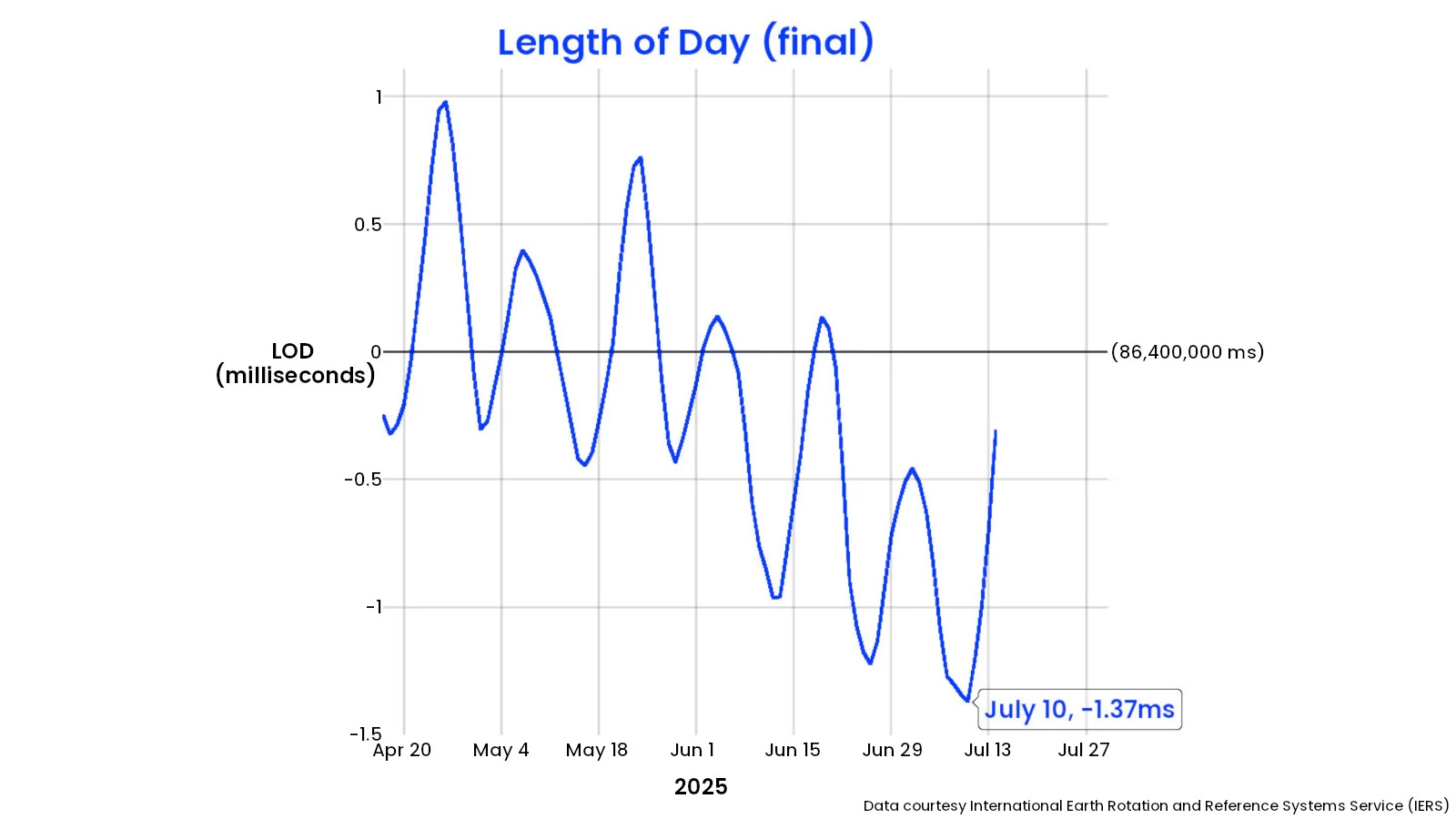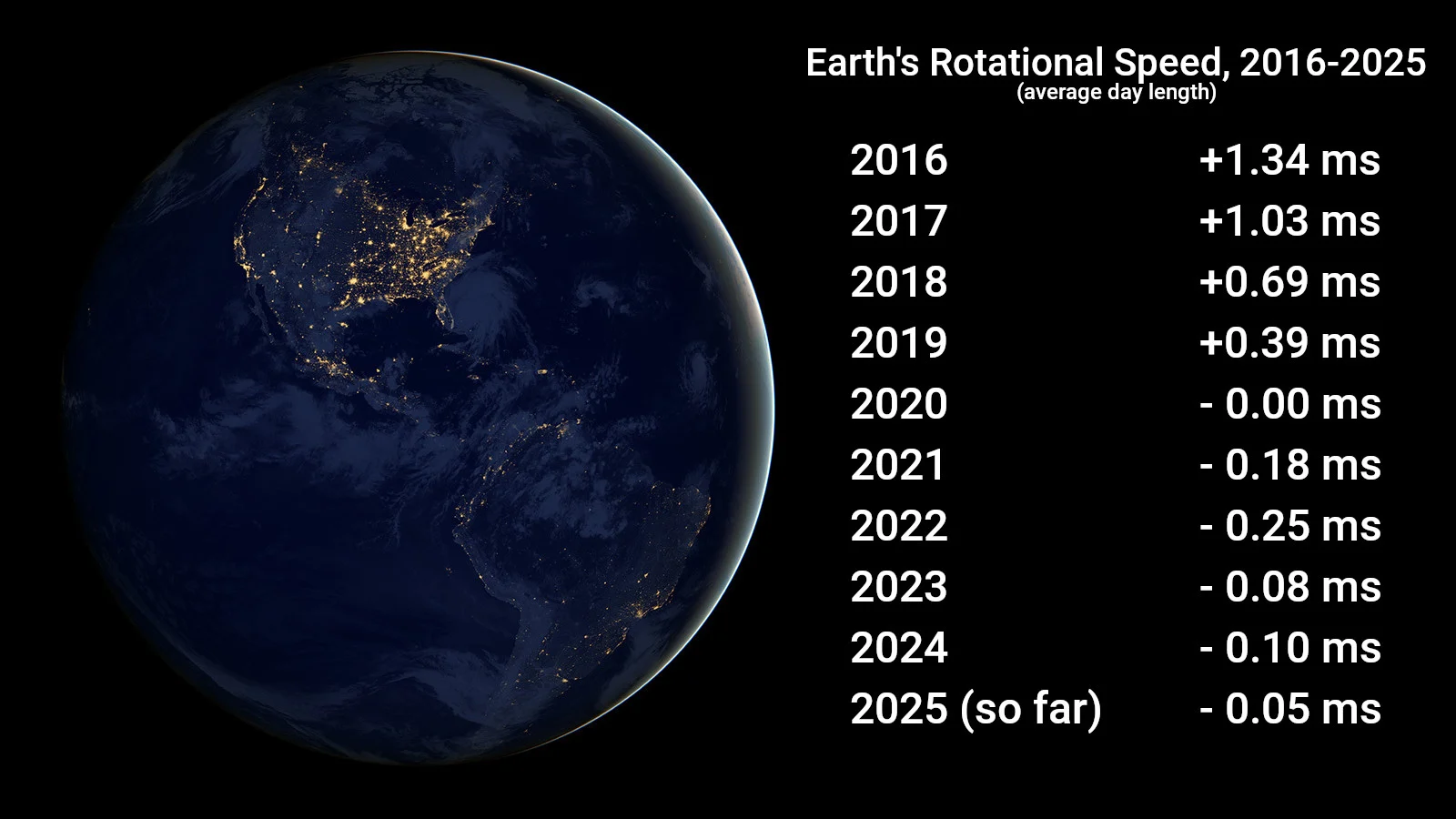
Earth just had one of its shortest days in over 50 years
Did you feel that? The planet spun a bit faster last week, by enough to give us our shortest day of the year, so far.
July 10, 2025 was the shortest day of this year, so far, as well as one of the shortest days the planet has seen since atomic clocks were invented. The odd thing is, we're not exactly sure why!
The length of each day here on Earth, at 24 hours, is what's known as a solar day — the length of time it takes for planet to rotate around so that the Sun returns to the exact same position in the sky as the previous day. We define the length of day as equal to 86,400 seconds, and scientists track that timing, day by day, using extremely precise atomic clocks.

The western hemisphere of Earth at night. (NASA's Earth Observatory)
There's one complication, though. Only rarely is each day actually 86,400 seconds long.
Due to a variety of factors, our days are usually a tiny bit shorter or longer, on the order of 1 or 2 thousandths of a second (a.k.a. a milliseconds).
There are many things that influence Earth's rotation. Our distance from the Sun and the Moon's distance from Earth affect the tides, which can shorten or lengthen the day. The motions of Earth's core, mantle, and crust can do so as well. Even much more transient events, such as powerful hurricanes and earthquakes, have an effect, although much smaller (on the scale of millionths of a second, aka microseconds).
Plus, we've already seen how changes in the mass of glaciers near Earth's poles can change the length of day. This slows the planet's rotation by shifting the balance of the planet's mass away from its axis of rotation. It's similar to how a spinning ice skater can slow their rotation by extending their arms out, away from their torso.

READ MORE: Earth's days are getting longer due to melting polar ice
These changes to Earth's rotation follow a pattern, determined by a combination of all of those factors.
And there is a definite pattern! Over a half century of records now, the shortest day of each year has occurred in June, July, or August. Meanwhile, the longest day has usually been sometime between March and May, but occasionally happened in October or November. There is even a shorter pattern of oscillations overlaid on top of that longer pattern, where the length of day swings back and forth between longer and shorter every 5-8 days or so.

This graph of length of day (in milliseconds over (+) or under (-1) the average of 86,400,000 ms) shows the unusual pattern in the lengthening and shortening of our days here on Earth. The data represented, ranging from April 17 through July 14, 2025, is the latest data available from the IERS as of July 16. (Data from IERS)
According to the International Earth Rotation and Reference Systems Service (IERS), in 2025, the longest day of the year so far was Saturday, March 29, at 1.12 milliseconds longer than usual.
The shortest day of the year, so far, was Thursday, July 10, at 1.37 milliseconds shorter than usual.
That's not the shortest day in history. July 5, 2024 still holds that title, at least over the past half-century or so, at 1.66 ms shorter.
However, based on the data presented by TimeandDate.com, July 10, 2025 is the fifth shortest day, going back to 1973.
This, in of itself, is rather odd. From 1973 through 2019, each year has seen an average length of day greater than usual, and the tally of all that 'extra time' at the end of each year has added up to anywhere from 100 to 1,100 milliseconds. In fact, this is the reason why we have introduced leap seconds into our calendar.
So far, there have been 25 leap seconds added, either on June 30 or December 31 of any specific year. This happened when the total yearly differences in the actual time vs the standard time added up to around 1 second or more. Sometimes it took more than one year for that extra time to accumulate, thus putting the need for a new leap second on pause.
The last leap second was added on December 31, 206. After that, something unusual began, as days became shorter, on average. Since 2020, Earth has been accumulating 'negative time', so to speak. The average length of day and the total yearly difference have both been negative for each year of the past 5 years, and also for 2025, so far.

This table reveals how Earth's days have been getting shorterly in recent years. (Earth at night courtesy NASA's Earth Observatory. Data courtesy IERS via timeanddate.com)
"Nobody expected this," Leonid Zotov, a leading authority on Earth's rotation at Moscow State University, told timeanddate.com. "The cause of this acceleration is not explained."
According to Zotov, most researchers believe it may be something inside the Earth that is causing the days to get shorter right now.
Zotov's original prediction for 2025, as reported by timeanddate.com, stated that there would be three remarkably short days this summer.
July 9 was supposed to be the first, at 1.3 ms shorter than normal. This has been verified, as the actual day was 1.34 ms shorter. July 10 wasn't part of his predictions, but that day went on to be even shorter. After this, July 22 is supposed to be the next shortest day, at -1.38 ms, followed by August 5, which was predicted to be the shortest of 2025, at -1.51 ms.
However, an update posted on July 10 revised those two upcoming days, with July 22 forecast to come in at -1.34 ms, and August 5 at -1.24 ms. We'll have to see what actually happens for the rest of the season to confirm it, but we may have already had our shortest day of the year.
As for when the trend might reverse, Zotov has seen indictations, in early 2024 and again in early 2025, that the acceleration may be slowing.
"I think we have reached the minimum," he told timeanddate.com. "Sooner or later, Earth will decelerate."
